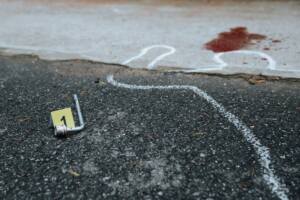Blood Evidence: Collection and Preservation
 The collection and preservation of blood stain evidence is important because this evidence can be used to type blood or run DNA analysis.
The collection and preservation of blood stain evidence is important because this evidence can be used to type blood or run DNA analysis.
There are two different types of blood that can be collected at a crime scene: liquid and dried blood. Liquid blood evidence is generally collected from blood pools but can be collected off of clothing as well, using a gauze pad or a sterile cotton cloth. Once the sample is collected it must be refrigerated or frozen and brought to the laboratory as quickly as possible. The sample must first be dried thoroughly at room temperature. It is important to get the sample to the laboratory as quickly as possible because after 48 hours the sample might be useless. If the sample has to be mailed it should be completely air dried before packaging. If the sample isn’t completely dry when it needs to be packaged, the sample should be rolled in paper and labeled and then put into either a brown paper bag or a box. The paper bag or box is then sealed and labeled again. It is important to only place one item per container to avoid contamination and samples should not be placed in plastic containers. Samples shouldn’t be in plastic containers because if the sample is still damp the moisture from the sample can cause microorganisms that can destroy the evidence. Also, due to this fact, samples should not be in any container for more than two hours.
Dried bloodstains can be found on small objects, larger objects and on clothing. When dried blood is found on a small object the entire object can be sent to the lab after it’s been properly packaged and labeled. When dried blood is found on a larger object that is transportable, an investigator should cover the stained area with paper and tape the paper to the object to avoid contamination. If the object that is stained is not transportable there are different ways that an investigator can collect the sample. One option is to cut out the stained area of the large object. If the portion is cut out the sample is packaged the same way as described above but a control sample should also be provided in a separate package. Another option is to use fingerprint tape and lift the sample as well as the surrounding control area. If this method is used it is important for investigators to not touch the sticky side of the tape with bare hands and the investigator should run an eraser or some type of blunt object over the placed tape to ensure that contact is made with the dried stain. The lifted stain is then be packaged and labeled, then delivered to the laboratory. Another way to collect a sample off of an object is to use a clean sharp object to scrape flakes of the stain into a paper packet. The last two methods of collection of a dried bloodstain on a large object require the use of distilled water to dampen the stain before rolling a thread in the stain or absorbing the stain with a cotton square. These two methods are not recommended due to the risk of contamination. When dried blood is found on clothing the entire article of clothing should be packaged and labeled and delivered to the lab.
It is important for the investigator to remember to keep each sample separated so that there is no contamination between samples.
Back to Forensic Investigation
Back to Crime Library
|
|
|

